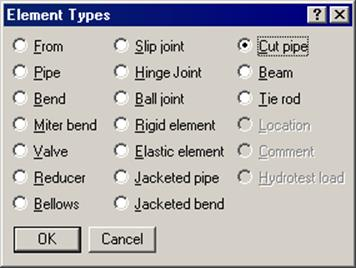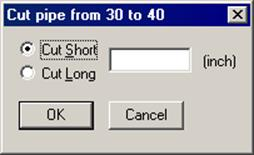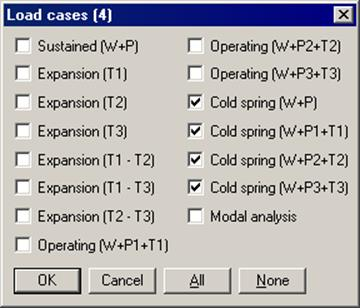Cold Spring (Cut Pipe)
Cold spring (cut short or cut long) is used to reduce thermal forces on equipment connected to the piping system. When lengths of pipes are cut short or extended by design, they are pulled together or pushed apart to join them during installation, giving rise to a “cold-sprung” system.
Such an installation process (cold condition) obviously introduces stresses, which are relieved when the system starts up (hot condition). Note however, that the piping codes do not allow credit for any reduction in stresses due to cold spring since the displacement range is unaffected (similar to self-springing. See B31.1 para. 119.2 for details). But, codes allow reduction in support loads due to cold spring (which can be helpful at the equipment).
This feature should be used only with a proper understanding of the implications.
Cold spring for a straight pipe is input by typing “c” in the Type column or selecting “Cut pipe“ from the Element Types dialog.

The Cut pipe dialog is shown.

Select “Cut short” or “Cut long” using the radio buttons. The amount of cut (short or long) should be positive.
Since the piping codes do not allow credit for cold spring in stress calculations, a cold spring is used in additional sustained and operating load cases (designated “Cold Spring (W+P), Cold Spring (W+P1+T1)” etc.) which are not used in stress calculations but are used for support loads and equipment qualification reports.
Cold Spring load cases appear in the Loads menu (under Load cases) after a cold spring (Cut pipe element) is input into the model. The Load cases menu is shown next:

For analysis, select the desired Cold Spring load cases from those shown. The built-in Hanger selection procedure does not consider the cold spring since the selection is based on the first Operating (W+P1+T1) load case. However, if Cold Spring is used, the hanger loads for the Cold spring load cases [for example, Cold Spring (W+P1+T1)] will include the effect of the Cold spring.
For an example on Cold Spring modeling and its use in reducing Anchor loads for operating load case(s), refer http://www.sstusa.com/caepipe-tutorials.php.